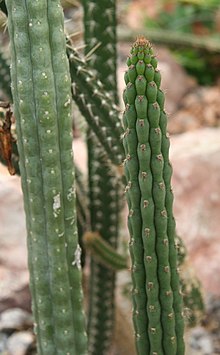Yungasocereus
| Yungasocereus | |
|---|---|

| |
| Scientific classification | |
| Kingdom: | Plantae |
| Clade: | Tracheophytes |
| Clade: | Angiosperms |
| Clade: | Eudicots |
| Order: | Caryophyllales |
| Family: | Cactaceae |
| Subfamily: | Cactoideae |
| Tribe: | Cereeae |
| Subtribe: | Trichocereinae |
| Genus: | Yungasocereus F.Ritter[3] |
| Species: | Y. inquisivensis
|
| Binomial name | |
| Yungasocereus inquisivensis | |
| Synonyms[2] | |
| |
Yungasocereus is a monotypic genus of cacti. Its sole species is Yungasocereus inquisivensis, native to Bolivia.[3]
Description[edit]
It is a columnar cactus, appearing either as a tree or shrub, ranging up to 4–5 meters in height. The 6–7 cm diameter stems are dark green, with 6-10 ribs. The 1.5–3 cm spines are in groups of 4-12, with no differentiation into central and radial types, and range from a brownish to grayish color. The flowers are white, appearing in groups of 5-8 near the stem tips. They open day and night and are 5 to 6 centimeters long.
The fruits have a length between 2 and 2.8 centimeters. They contain small, broadly oval, shiny black, slightly keeled seeds on the back, 0.9 millimeters long and 0.7 millimeters wide.[4]
Taxonomy[edit]
Martín Cárdenas described the species in 1957 from Inquisivi, placing it in Samaipaticereus.[5] Friedrich Ritter later found the same species in Yungas. In 1980, he gave the cactus its own genus, Yungasocereus.[6] After a period in Haageocereus, this was again separated into Yungasocereus.
Distribution[edit]
This cactus is known only from Yungas and Inquisivi provinces of La Paz Department, where it is found at elevations of around 1000 to 2300 meters.[citation needed]
References[edit]
- ^ "The IUCN Red List of Threatened Species". IUCN Red List of Threatened Species. 2010-09-22. Retrieved 2023-09-04.
- ^ a b "Yungasocereus inquisivensis (Cárdenas) F.Ritter". Plants of the World Online. Royal Botanic Gardens, Kew. Retrieved 2023-10-16.
- ^ a b "Yungasocereus F.Ritter". Plants of the World Online. Royal Botanic Gardens, Kew. Retrieved 2023-10-16.
- ^ Anderson, Edward F.; Eggli, Urs (2005). Das grosse Kakteen-Lexikon (in German). Stuttgart (Hohenheim): Ulmer. p. 646. ISBN 3-8001-4573-1.
- ^ "Au Cactus Francophone". Au Cactus Francophone (in French). Retrieved 2023-09-04.
- ^ "Au Cactus Francophone". Au Cactus Francophone (in French). Retrieved 2023-09-04.
- Edward F. Anderson, The Cactus Family (Timber Press, 2001), p. 681
External links[edit]
 Media related to Yungasocereus at Wikimedia Commons
Media related to Yungasocereus at Wikimedia Commons Data related to Yungasocereus inquisivensis at Wikispecies
Data related to Yungasocereus inquisivensis at Wikispecies

